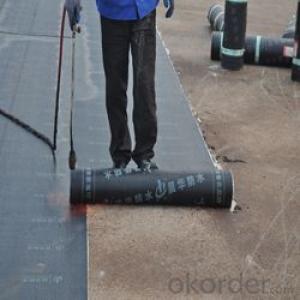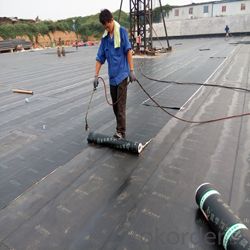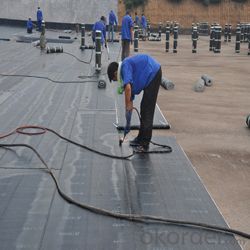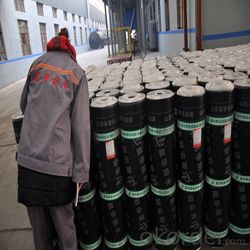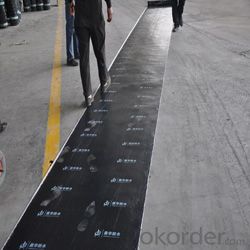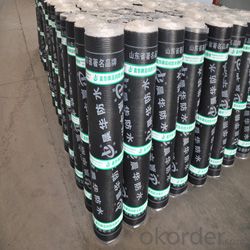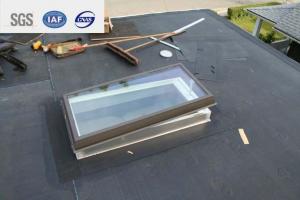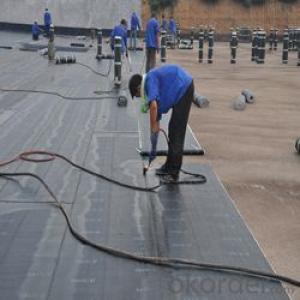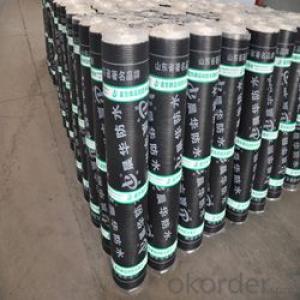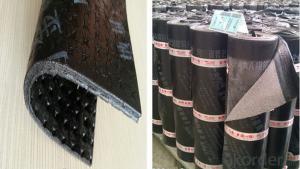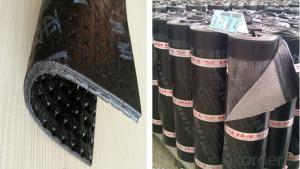SBS modified bitumen waterproof membrane
OKorder Service Pledge
OKorder Financial Service
You Might Also Like
Specification:
Width:1m
Length/roll:7.5m/10m/15m or as your need.
Surface:PE film/Granules/Sand etc.
Thickness:3mm\4mm.
Characteristic:
a) SBS modified bitumen waterproof membrane is specially used as waterproof material in cold area
b) APP is specially suitable for areas of high temperature and of strong sun-shine
SBS/APP Modified Bitumen Waterproof Membrane
c)Good performance in good impermeability ,anti-puncture, anti-broker, anti-resistance, anti-erosion, anti-mildew, anti-weathering
d)Possess good tensile strength, elongation rate and size stability which could be well suited the substrate
distortion and crack
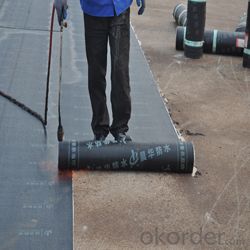
- Q: Can a waterproofing membrane be used in renovation projects?
- Yes, a waterproofing membrane can be used in renovation projects. It is a common and effective method to prevent water damage and leakage in areas such as basements, bathrooms, and roofs during the renovation process. By installing a waterproofing membrane, it helps create a barrier against water penetration, ensuring the longevity and durability of the renovated area.
- Q: Can a waterproofing membrane be used on roofs with standing water or ponding?
- No, a waterproofing membrane should not be used on roofs with standing water or ponding. While waterproofing membranes are designed to provide a protective barrier against water penetration, they are not meant to be submerged or exposed to constant water accumulation. Standing water or ponding on a roof can cause a variety of issues, such as increased weight load, potential structural damage, and increased risk of leaks. It is important to address any drainage issues and ensure proper roof slope to prevent standing water before considering the application of a waterproofing membrane.
- Q: Can a waterproofing membrane be used for a swimming pool liner installation?
- Certainly! When it comes to installing a swimming pool liner, utilizing a waterproofing membrane is indeed a viable option. These membranes are meticulously crafted to establish a formidable shield against water infiltration, rendering them a superb selection for pool lining purposes. Typically composed of resilient substances like PVC or EPDM, these membranes possess remarkable resistance to both chemicals and UV rays. Consequently, they proficiently halt the permeation of water through the pool structure, shielding it from the detrimental effects induced by moisture. Moreover, the flexibility inherent in waterproofing membranes enables effortless tailoring to accommodate pools of diverse shapes and dimensions, ensuring a flawless and impervious installation.
- Q: Can a waterproofing membrane be used for power plants?
- Indeed, power plants can make use of waterproofing membranes. Waterproofing membranes find widespread use in various settings where the prevention of water penetration is essential, and power plants are no exception to this. Within power plants, there are often sections that come into contact with water, such as cooling towers, wet flue gas desulfurization systems, and other water management systems. Incorporating waterproofing membranes within these areas aids in safeguarding the structures and equipment against water damage, corrosion, and leaks. Furthermore, underground structures like basements or tunnels, which are frequently present in power plants, can also benefit from the application of waterproofing membranes. These membranes act as a reliable barrier against water infiltration, thereby ensuring the durability and longevity of the power plant structures. Consequently, the utilization of a waterproofing membrane emerges as a practical and advantageous solution for maintaining the performance and dependability of power plant facilities.
- Q: Can a waterproofing membrane be used on tunnels with architectural features?
- Indeed, tunnels with architectural features can benefit from the application of a waterproofing membrane. Such membranes possess versatility, enabling their usage on different structures, including tunnels with architectural elements. Their primary purpose is to establish a protective barrier against water infiltration, consequently safeguarding the structure against moisture-related harm. Regardless of the tunnel's unique architectural components, such as curves, arches, or decorative embellishments, a tailored waterproofing membrane can be tailored and implemented to ensure optimal water resistance. Therefore, it is imperative to seek guidance from a proficient waterproofing specialist experienced in working with tunnels and architectural features. They will assist in determining the most suitable membrane system for the specific project prerequisites.
- Q: Can a waterproofing membrane be used for roofing?
- A waterproofing membrane is a suitable option for roofing and is commonly chosen for many roofing applications. Its purpose is to create a barrier that prevents water from infiltrating, thus preventing leaks and water damage on roofs. These membranes are typically made of durable materials like asphalt, synthetic rubber, or thermoplastic, which are resistant to water and can endure harsh weather conditions. They are installed on top of the roof surface, forming a seamless and watertight layer that keeps the interior of the building dry and safeguarded. Moreover, waterproofing membranes can be used on various types of roofs, including flat, sloped, and even green roofs. Ultimately, opting for a waterproofing membrane for roofing is an effective way to ensure long-lasting durability and protection against water damage.
- Q: Can waterproofing membranes be used on both horizontal and vertical surfaces?
- Waterproofing membranes possess the capability to be utilized on both horizontal and vertical surfaces. These membranes have been specifically engineered to furnish a protective shield against water infiltration, and they can be implemented on a diverse array of surfaces, encompassing roofs, walls, floors, and even subterranean structures. Their application is incredibly versatile, enabling them to safeguard horizontal surfaces, such as flat roofs or balconies, while also affording protection to vertical surfaces, including walls or foundations. The adaptability and resilience of waterproofing membranes render them highly suitable for a vast spectrum of construction projects, guaranteeing that water does not permeate and inflict harm upon the structure.
- Q: Are there any specific installation techniques for corners and edges when using a waterproofing membrane?
- Yes, when installing a waterproofing membrane on corners and edges, it is important to follow specific techniques. First, ensure that the membrane extends beyond the corner or edge by at least 6 inches to provide adequate coverage. Next, carefully fold and crease the membrane to create a tight seal around the corner or edge. Use a heat gun or adhesive to secure the folded membrane in place. Additionally, apply a layer of sealant or waterproofing tape over the folded membrane to further reinforce the corner or edge. These techniques help prevent water penetration and ensure effective waterproofing in these vulnerable areas.
- Q: Is a waterproofing membrane compatible with different types of flooring materials?
- Yes, a waterproofing membrane is compatible with different types of flooring materials. A waterproofing membrane is designed to create a barrier between the subfloor and the flooring material, preventing moisture from seeping through and causing damage. This makes it suitable for use with various flooring types such as laminate, vinyl, tile, and even hardwood. The waterproofing membrane ensures that the flooring material remains protected from water damage, extending its lifespan and maintaining its appearance. However, it is important to note that different types of waterproofing membranes may have specific compatibility requirements, so it is recommended to consult the manufacturer's guidelines to ensure proper installation with the chosen flooring material.
- Q: Can a waterproofing membrane be used for historical buildings?
- Yes, a waterproofing membrane can be used for historical buildings. While it is important to preserve the architectural integrity and historical value of such buildings, it is equally essential to protect them from water damage. Waterproofing membranes provide an effective solution to prevent water infiltration and subsequent decay or deterioration. These membranes can be applied to various surfaces, including roofs, walls, and foundations, without compromising the aesthetics of the historical structure. It is crucial to choose a waterproofing membrane that is suitable for historical buildings, considering factors such as breathability, compatibility with the existing materials, and adherence to preservation guidelines. By using a carefully selected and properly installed waterproofing membrane, historical buildings can be protected from moisture-related issues, ensuring their longevity and continued preservation.
Send your message to us
SBS modified bitumen waterproof membrane
OKorder Service Pledge
OKorder Financial Service
Similar products
Hot products
Hot Searches
Related keywords
